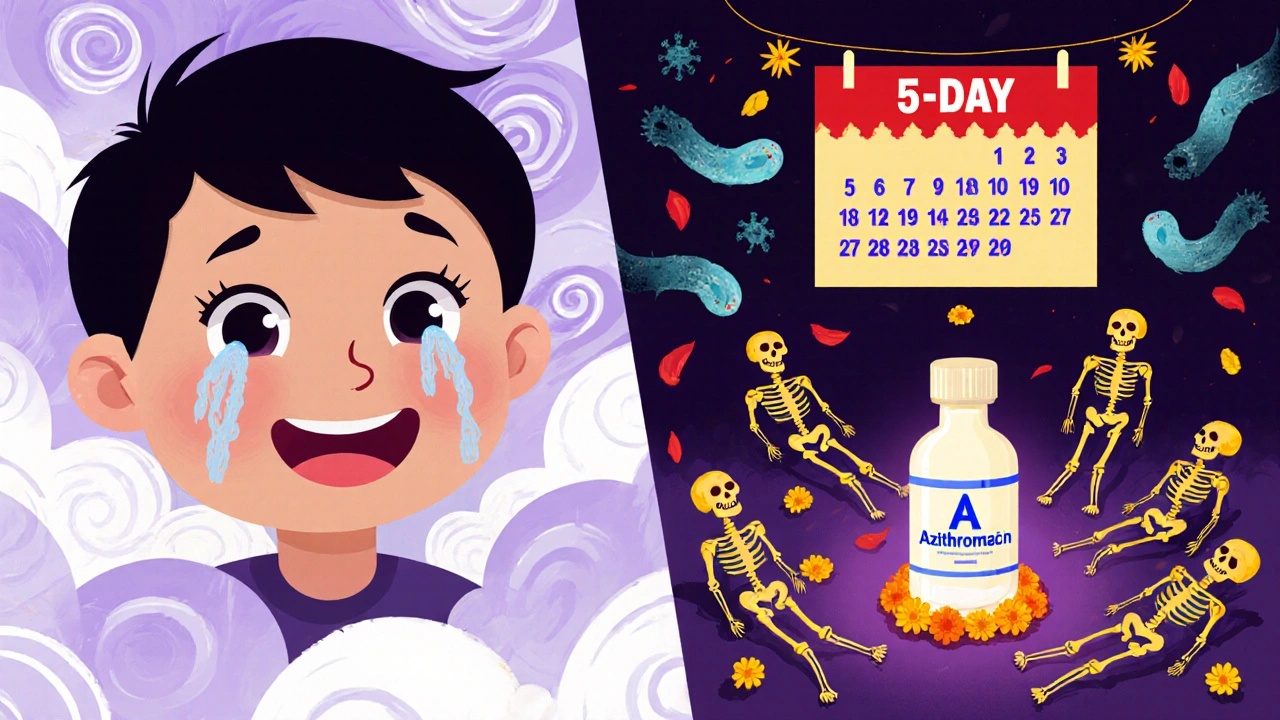When a child starts tugging at their ear, crying more than usual, or refuses to lie down at night, it’s often an ear infection. These are among the most common reasons parents take their kids to the doctor. But not all ear infections need antibiotics-and when they do, azithromycin is one of the options doctors turn to. It’s not the first choice for every case, but it has real benefits in specific situations. So how does azithromycin actually work for ear infections, and when does it make sense to use it?
What causes ear infections?
Most ear infections, especially in kids, are caused by bacteria like Streptococcus pneumoniae, Haemophilus influenzae, and Moraxella catarrhalis. These germs often spread from the throat or nose into the middle ear through the eustachian tube, which is shorter and more horizontal in children. That’s why kids under 5 get ear infections way more often than adults.
Not every ear infection needs antibiotics. Many clear up on their own within a few days. But if the infection is severe-high fever, intense pain, or fluid draining from the ear-antibiotics become necessary. That’s where azithromycin comes in.
What is azithromycin?
Azithromycin is an antibiotic in the macrolide family. It’s sold under brand names like Zithromax and Zmax. Unlike penicillin-based drugs like amoxicillin, which kill bacteria directly, azithromycin stops them from making proteins they need to grow and multiply. This gives the body’s immune system a better chance to clear the infection.
One big advantage of azithromycin is its dosing schedule. While amoxicillin usually requires taking pills two to three times a day for 7-10 days, azithromycin often works with just one dose a day for 3 to 5 days. For kids, it’s often given as a single dose on day one, then one daily dose for four more days. Some forms even come as a single, large dose that covers the whole treatment.
Why choose azithromycin over amoxicillin?
Amoxicillin is still the go-to first-line antibiotic for ear infections in most guidelines. But azithromycin is used when:
- The patient is allergic to penicillin or amoxicillin
- The infection didn’t improve after 48-72 hours on amoxicillin
- The child has trouble swallowing pills or refuses to take medicine multiple times a day
- There’s a known local resistance pattern to amoxicillin
According to data from the CDC and the American Academy of Pediatrics, about 15-20% of ear infections don’t respond to amoxicillin. That’s partly because of rising bacterial resistance. In areas where Streptococcus pneumoniae has developed resistance to penicillin, azithromycin can be a more effective alternative.
Another practical reason: the shorter course. Parents often struggle to get kids to finish a full 10-day antibiotic. With azithromycin, the treatment ends sooner, which improves compliance. A 2023 study in the Journal of Pediatric Infectious Diseases found that 92% of parents completed the azithromycin course compared to 78% for amoxicillin.
How effective is azithromycin for ear infections?
Studies show azithromycin clears up bacterial ear infections in about 85-90% of cases when used correctly. That’s slightly lower than amoxicillin’s 90-95% success rate-but the difference isn’t huge. The real benefit comes in convenience and tolerance.
Azithromycin also works well against certain bacteria that amoxicillin doesn’t touch as effectively. For example, Moraxella catarrhalis, which causes about 20% of ear infections, responds better to azithromycin than to some older antibiotics.
But here’s the catch: azithromycin doesn’t work for viral ear infections. If the infection is caused by a cold or flu virus, antibiotics won’t help-and using them unnecessarily can lead to side effects or antibiotic resistance. That’s why doctors often wait 48 hours before prescribing, especially if symptoms are mild.

Dosage and how it’s given
Dosage depends on the patient’s weight and age. For children, the typical dose is 10 mg per kilogram of body weight on day one, followed by 5 mg per kg on days two through five. That’s usually given as a liquid suspension.
For adults, it’s often a 500 mg dose on day one, then 250 mg daily for four more days. Some formulations offer a single 2-gram dose for adults, though this is less common for ear infections and more often used for other infections like chlamydia.
It’s best taken on an empty stomach-about an hour before or two hours after eating. But if it upsets the stomach, it can be taken with food. The liquid form tastes better when chilled, and many pharmacies offer flavoring options like cherry or bubblegum.
Side effects and risks
Azithromycin is generally well-tolerated. The most common side effects are mild: stomach pain, nausea, vomiting, or diarrhea. These usually go away after a day or two.
More serious risks are rare but real. Azithromycin can affect heart rhythm in people with existing heart conditions, especially those with long QT syndrome. The FDA issued a warning in 2013 about this risk, and it’s still something doctors check for before prescribing, especially in older adults or those on other heart medications.
There’s also a small risk of developing Clostridioides difficile (C. diff) infection, which causes severe diarrhea. This can happen with any antibiotic, but azithromycin’s longer half-life means it stays in the body longer, potentially increasing the risk slightly.
And while azithromycin is less likely to cause allergic reactions than penicillin, it’s still possible. Signs include rash, swelling, or trouble breathing. If these happen, stop the medicine and get medical help right away.
When not to use azithromycin
Azithromycin isn’t right for every ear infection. Avoid it if:
- The infection is clearly viral (no fever, mild symptoms, recent cold)
- The patient has had severe liver disease or a history of cholestatic jaundice from azithromycin
- The person is taking medications that interact badly with azithromycin, like certain statins, antacids, or antiarrhythmics
Also, don’t use leftover azithromycin from a previous illness. Antibiotics are not one-size-fits-all. The wrong dose or wrong drug can lead to treatment failure or resistance.

What to expect during treatment
Most people start feeling better within 24-48 hours of starting azithromycin. Pain should ease, fever should drop, and irritability in kids should improve. But even if symptoms disappear, finish the full course. Stopping early can leave behind the toughest bacteria, which then multiply and cause a stronger return of the infection.
If there’s no improvement after 48 hours, or if symptoms get worse (new fever, swelling behind the ear, fluid draining), call your doctor. That could mean the infection is resistant, or it’s something else-like a ruptured eardrum or a more serious condition like mastoiditis.
Alternatives to azithromycin
Other antibiotics used for ear infections include:
- Amoxicillin - First-line, effective, affordable
- Amoxicillin-clavulanate - Used when amoxicillin fails; adds a booster to fight resistant bacteria
- Cefdinir, cefuroxime - Cephalosporins for penicillin-allergic patients
- Ceftriaxone - Given as a shot for severe cases or when oral meds aren’t possible
For mild cases, doctors may recommend pain relief with ibuprofen or acetaminophen and watchful waiting. Ear drops with numbing agents can also help with pain, especially if the eardrum is intact.
Preventing future ear infections
Reducing ear infections isn’t just about antibiotics-it’s about prevention:
- Get flu and pneumococcal vaccines-they lower the risk of infections that lead to ear problems
- Avoid secondhand smoke-it irritates the eustachian tubes
- Limit pacifier use after 6 months
- Feed babies upright to reduce milk flowing into the middle ear
- Use saline drops and suction to clear nasal congestion during colds
Children who get frequent ear infections (three or more in six months) may need to see an ENT specialist. In some cases, ear tubes are recommended to help drain fluid and prevent recurring infections.
Final thoughts
Azithromycin isn’t the magic bullet for every ear infection, but it’s a valuable tool when used the right way. Its short course, good tolerability, and effectiveness against certain bacteria make it a smart choice for some patients-especially those allergic to penicillin or struggling with daily dosing.
The key is working with your doctor to know when it’s needed and when it’s not. Antibiotics save lives-but only when they’re used correctly. Don’t ask for azithromycin just because it’s easier. Let your doctor decide based on symptoms, history, and what’s best for your body-or your child’s.
Is azithromycin safe for children with ear infections?
Yes, azithromycin is commonly prescribed for children with bacterial ear infections. It’s approved for use in kids as young as 6 months old. The dosage is based on weight, and it’s usually given as a liquid. Side effects like stomach upset are common but mild. Always follow your doctor’s dosing instructions and complete the full course.
Can azithromycin treat viral ear infections?
No, azithromycin only works against bacterial infections. Most ear infections in children start with a virus, like a cold, and only turn bacterial if they last more than a few days. Antibiotics won’t help if the cause is viral. Doctors often wait 48-72 hours before prescribing to see if the body clears the infection on its own.
How long does it take for azithromycin to work on an ear infection?
Most people notice improvement within 24 to 48 hours. Pain and fever should start to ease, and irritability in children should decrease. But even if symptoms disappear, finish the full course-usually 5 days-to make sure all the bacteria are gone. Stopping early can lead to a stronger return of the infection.
What are the side effects of azithromycin?
Common side effects include nausea, diarrhea, stomach pain, and vomiting. These usually go away on their own. Rare but serious side effects include irregular heartbeat (especially in people with heart conditions), severe diarrhea from C. diff infection, and allergic reactions like rash or swelling. Contact a doctor immediately if you experience chest pain, dizziness, or trouble breathing.
Can you take azithromycin if you’re allergic to penicillin?
Yes, azithromycin is often prescribed for people allergic to penicillin because it belongs to a different antibiotic class (macrolides). It’s a common alternative when amoxicillin can’t be used. However, always tell your doctor about any allergies-even if they’re mild-so they can choose the safest option.
Does azithromycin cause antibiotic resistance?
Any antibiotic can contribute to resistance if used improperly. Taking azithromycin when it’s not needed, not finishing the full course, or using it too often increases the risk. That’s why doctors only prescribe it when they’re sure it’s a bacterial infection and other options aren’t suitable. Using it wisely helps protect its effectiveness for future cases.


Debra Callaghan
October 31, 2025 AT 16:32People just want the easy fix-give me the one-day pill and call it a day. But antibiotics aren’t candy. If your kid has a runny nose and is cranky, wait 48 hours. Most ear infections clear on their own. Stop rushing to the doctor for azithromycin like it’s a magic wand.
Mitch Baumann
November 1, 2025 AT 20:12Let’s be honest-azithromycin’s appeal is less about efficacy and more about compliance… and let’s not pretend the pharmaceutical marketing machine hasn’t pushed this macrolide as the ‘convenient’ alternative. 🤓 The real win? A 5-day course that fits neatly into a parent’s chaotic schedule… and maybe, just maybe, a few extra prescriptions for the clinic. 🍭
Gina Damiano
November 2, 2025 AT 20:39I gave my 3-year-old azithromycin last winter and she was back to her silly self in 24 hours. But I also did the whole warm compress, elevated headboard, and honey-on-toast routine (she’s over 1). It’s not just the pill-it’s the whole vibe. I wish more doctors talked about the non-drug stuff too.
Emily Duke
November 4, 2025 AT 00:08OMG I CANT BELIEVE PEOPLE STILL ASK IF IT WORKS FOR VIRAL INFECTIONS?? LIKE DUH. ITS AN ANTIBIOTIC. NOT A CURE FOR COLD. I HAD A DOCTOR PRESCRIBE IT FOR MY KID’S COLD LAST YEAR AND I WAS LIKE… NOPE. NOW I DO MY OWN RESEARCH. #antibioticresistance #dontbeanidiot
Stacey Whitaker
November 4, 2025 AT 08:16Living in Australia, we’re taught to wait. Watch. Wait some more. Antibiotics are a last resort here. Azithromycin? Sure, if it’s needed. But I’ve seen way too many parents panic and demand it. The body’s smart. Let it fight. We’re not in a race to fix everything right now.
Kayleigh Walton
November 4, 2025 AT 09:52Hey everyone-I’m a pediatric nurse and I see this every week. Azithromycin isn’t perfect, but when a kid can’t swallow pills or the family is struggling with daily dosing, it’s a game-changer. I always remind parents: finish the whole course, even if they feel better. And yes, it’s okay to ask your doctor, ‘Is this really necessary?’ You’re not being difficult-you’re being responsible.
Stephen Tolero
November 4, 2025 AT 19:45What is the clinical efficacy differential between azithromycin and amoxicillin-clavulanate in cases of recurrent otitis media with effusion? Are there any meta-analyses controlling for regional resistance patterns?
Brooklyn Andrews
November 5, 2025 AT 15:04My sister’s kid got azithromycin and threw up for two days. Then got C. diff. Now she’s on probiotics and a whole new diet. This isn’t harmless. Don’t treat it like a Band-Aid. It’s a sledgehammer.
Joanne Haselden
November 6, 2025 AT 23:26Given the pharmacokinetic profile of azithromycin-its prolonged half-life and tissue penetration-it’s particularly advantageous in biofilm-associated otitis media, especially in recurrent cases where conventional beta-lactams fail. However, the risk-benefit calculus must account for microbiome disruption and potential QT prolongation in predisposed populations. A nuanced approach is non-negotiable.
Vatsal Nathwani
November 7, 2025 AT 06:35Why even use this? Just give amoxicillin. Everyone knows it works. Azithromycin is just fancy marketing. I don’t get why doctors waste time with this. Also, my cousin took it and got diarrhea for a week. Not worth it.
Saloni Khobragade
November 8, 2025 AT 21:55my kid got this last year and i forgot to give the last dose bc i thought she was better… now she gets ear infections every 2 months. i feel so guilty. pls finish the whole thing. even if its just 5 days.